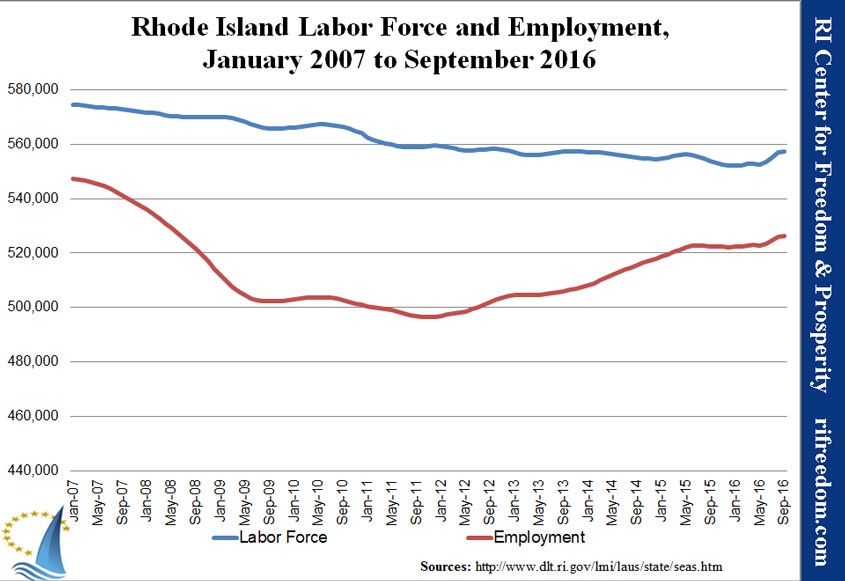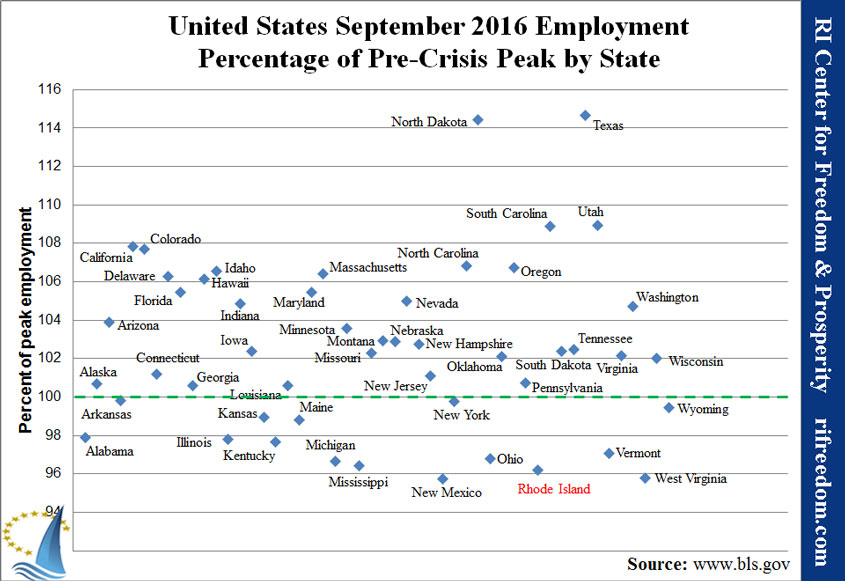September 2016 Employment: Cresting a Diminutive Peak?
Rhode Island’s employment and labor force increases were smaller, in September, than they had been in August, and the decrease in jobs based in the state was larger, according to data from the federal Bureau of Labor Statistics (BLS). Revised numbers show employment up 443 people and labor force up 561, while 900 jobs disappeared.
As the following chart shows, the small increases on the employment side give the impression that Rhode Island’s relatively small boost in recent months — following a year of utter stagnation — may have come to an end.
That leveling off is in contrast with the experience of Rhode Island’s neighbors, Connecticut and Massachusetts. Both saw more significant gains, with more Massachusetts residents currently employed than were in the whole labor force just before the recession.
As for the action among Rhode Island’s peers at the back of the national pack, the Ocean State remains third to last when it comes to employment regained compared with each state’s pre-crisis peak. However, West Virginia has effectively closed the gap with Rhode Island and New Mexico, leaving a nail-biter in the race to see which state can leave the greatest proportion of its population behind by the end of 2016.
The following chart shows that Rhode Island’s loss of jobs based in the state brought the total back below its level in March of this year. All in all the increase in jobs remains slow. Slow long-term growth is one thing that employment and jobs numbers have in common in Rhode Island.
Readers looking for some way to be happy about trends may find a toe-hold in the following chart. Because labor force has been increasing more than employment, the state’s unemployment rate has actually gone up. However, for the same reason, its unemployment rate would be going down if so many Rhode Islanders hadn’t simply stopped looking for work. Rather than an unchanged unemployment rate of 5.6%, in September, Rhode Island would have experienced an unemployment rate drop to 8.4%.
Finally, with a turn toward the more-comprehensive Jobs & Opportunity Index (JOI) of the RI Center for Freedom & Prosperit, which takes into account 13 datapoints, from employment to income and taxes, Rhode Island didn’t gain any ground. Indeed, in the New England race, the Ocean State fell farther behind as Vermont joined every other state in the region in making gains on the index.
Last month, Rhode Island’s score was hurt by a larger increase in taxes collected in the state during the second quarter of the year. This month, the pain came with a $589 million annualized drop in personal income during the same quarter (resulting from a downward revision of the data from the first quarter).
That change, more than anything, may be an indication that the state’s current strategy for growth is simply not working and should raise questions about the ability of government to continue collecting more and more taxes while the people become poorer.








